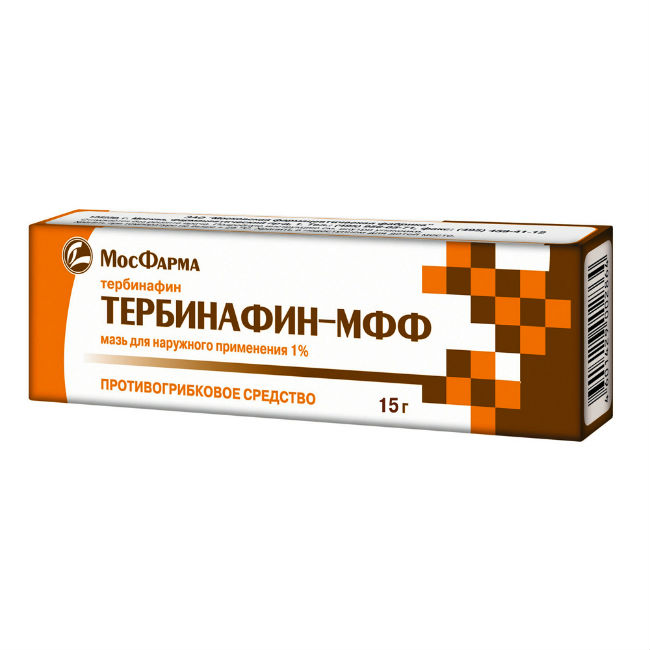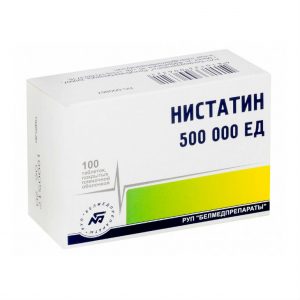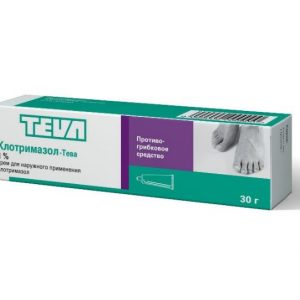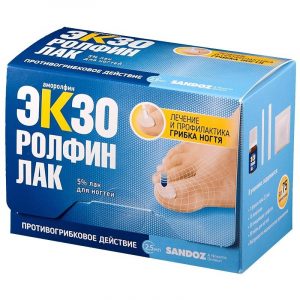Description
Latin name
Terbinafinum
Release form
ointment
Pharmacological action
Terbinafine is an antifungal agent. It has a wide spectrum of action against fungi that cause diseases of the skin, hair and nails, including:
dermatophytes, such as Trichophyton (e.g. T. rubrum, T. mentagrophytes, T. verrucosum, T. tonsurans, T. violaceum), Microsporum (e.g. M. canis), Epidermophyton floccosum
yeast of the genus Candida (e.g. C. albicans) and Pityrosporum.
In low concentrations, terbinafine has a fungicidal effect against dermatophytes, mold and some dimorphic fungi. Activity against yeast fungi, depending on their type, can be fungicidal or fungistatic.
The mechanism of action is associated with a specific suppression of the early stage of sterol biosynthesis in the fungal cell. This leads to a deficiency of ergosterol and to intracellular accumulation of squalene, which causes the death of the fungal cell.
The action of terbinafine is carried out by inhibiting the enzyme squalene epoxidase in the cell membrane of the fungus. This enzyme does not belong to the cytochrome P450 system. Terbinafine does not significantly affect the metabolism of hormones or other drugs.
Pharmacokinetics
When prescribing terbinafine orally in the skin, hair and nails, drug concentrations are created that provide a fungicidal effect.
After a single oral administration of terbinafine in a dose of 250 mg, its maximum plasma concentration is reached after 2 hours and is 0.97 mcg / ml. The half-absorption period is 0.8 hours, and the half-life is 4.6 hours. Although the bioavailability of terbinafine varies moderately under the influence of food, but not to the extent that dose adjustment is required.
Terbinafine binds significantly to plasma proteins (99%). It quickly penetrates the dermal layer of the skin and concentrates in the lipophilic stratum corneum. Terbinafine also penetrates the secretion of the sebaceous glands, which leads to the creation of high concentrations in the hair follicles, hair and in the skin, rich in sebaceous glands. Terbinafine has also been shown to penetrate the nail plates in the first few weeks after starting therapy.
Terbinafine is metabolized rapidly and substantially with the participation of at least seven isoenzymes of cytochrome P450, with the major role played by the isoenzymes CYP2C9, CYP1A2, CYP3A4, CYP2C8 and CYP2C19. As a result of the biotransformation of terbinafine, metabolites are formed that do not have antifungal activity and are excreted mainly in the urine. The final half-life is 17 hours.
There is no evidence of cumulation of the drug in the body. No changes in the equilibrium concentration of terbinafine in plasma depending on age were found, but in patients with impaired renal or hepatic function, the rate of excretion of the drug may be slowed, which leads to higher concentrations of terbinafine in the blood.
With topical application of a spray or cream, less than 5% of the dose is absorbed, thus the systemic effect of the drug is minimal.
Indications
Mycosis of the scalp (trichophytosis, microsporia).
Fungal diseases of the skin and nails (onychomycosis) caused by Trychophyton (T. rubrum, T. mentagrophytes, T. verrucosum, T. violaccum), Microsporum (M. canis, M. gypseum) and Epidermophyton floccosum.
Severe, common dermatomycosis of smooth skin of the trunk and extremities, requiring systemic treatment.
Candidiasis of the skin and mucous membranes.
Contraindications
Hypersensitivity, severe hepatocellular and renal failure, blood diseases, tumors, metabolic diseases, vascular pathology of the extremities, pregnancy, breast-feeding, children (up to 2 years).
Use during pregnancy and lactation
In experimental studies, no teratogenic properties of terbinafine were detected.
The use of the drug during pregnancy is possible in cases where the intended benefits to the mother outweigh the possible risk to the fetus.
Terbinafine is excreted in breast milk.
If you need to use the drug during lactation, you should decide whether to stop breastfeeding.
Composition of
1 g of ointment contains:
Active ingredient:
terbinafine hydrochloride 10 mg
Excipients:
methyl parahydroxybenzoate (methyl paraben),
sodium hydroxide (sodium hydroxide),
purified water.
Dosage and administration
Terbinafine can be applied to the skin 1 or 2 times a day. Before applying, it is necessary to clean and dry the affected areas. A thin layer is applied to the affected skin and adjacent areas and rubbed lightly. For infections accompanied by diaper rash (under the mammary glands, in the interdigital spaces, between the buttocks, in the inguinal region), the place of application of the cream can be covered with gauze, especially at night.
Average duration of treatment:
dermatomycosis of the trunk, limbs, legs: 1-2 weeks
dermatomycosis of the feet: 2-4 weeks
candidiasis of the skin: 1-2 weeks
versicolor versicolor: 2 weeks
mycosis of the nail plate: 3-6 months.
A decrease in the severity of clinical manifestations is usually observed in the early days of treatment. In the case of irregular treatment or premature termination of it, there is a risk of a renewed infection. If after two weeks of treatment there are no signs of improvement, the diagnosis should be verified.
Use of the drug in the elderly: There is no reason to assume that for the elderly it is necessary to change the dosage of the drug or that they have side effects that differ from those in younger patients.
Kids: Experience with children is limited.
Side effects
Sensation of heaviness and pain in the epigastric region, taste disturbance, loss of appetite, nausea, diarrhea, cholestasis, neutropenia, thrombocytopenia, skin allergic reactions, burning sensation, skin redness and itching in the area of application of the cream.
Overdose
Symptoms: headache, dizziness, nausea, vomiting, epigastric pain, increased urination, rash.
Treatment: Remediation measures (gastric lavage, activated charcoal intake) – symptomatic supportive therapy if necessary.
Storage conditions
Store at a temperature not exceeding 25 ° C.
Shelf suitability
3 Year
Deystvuyuschee substances
Terbinafine
Terms
pharmacy leave without a prescription
Dosage form
Leka GOVERNMENTAL form
ointment
Moscow pharmaceutical factory, Russia




